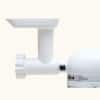Science: Can You Refreeze Meat?
Sometimes we thaw a piece of meat or poultry only to find that we don’t want to cook it that day after all. But then what? Can you refreeze the meat, or is it best to forge ahead and cook it?
EXPERIMENT
We cut a boneless chicken breast into three pieces. We cooked one portion from its fresh state. The second we froze, thawed, and then cooked. The third we froze, thawed, refroze, thawed again, and then cooked. We cooked all the samples to 160 degrees and weighed each piece of chicken before and after cooking to measure moisture loss. We then tasted all three samples, evaluating them for moistness and overall texture. We repeated the test six times, varying which section of the breast was used in each application.
RESULTS
The samples cooked from raw lost approximately 20 percent of their weight when cooked, those frozen once lost around 25 percent, and those frozen twice lost an average of 26 percent. Tasters preferred the samples that had never been frozen, noting moister meat and a more tender texture. This stands to reason, given the significant difference in moisture loss. But the surprising result was that, despite the small difference in moisture loss between the once-frozen and twice-frozen samples, tasters noted a significant difference between the two—the twice-frozen pieces seemed much drier and tougher than those frozen only once.
EXPLANATION
Cooking meat causes its muscle fibers to shrink and expel moisture. The process of freezing and then thawing leads to additional moisture loss because the sharp edges of ice crystals created during freezing damage the muscle fibers; this means that when the meat is thawed, water within the fibers is able to escape easily. However, most of this damage is done after just one freeze, so a second freeze can’t significantly exacerbate the effect. This explains why the amount of moisture loss was very similar whether the chicken was frozen once or twice.
So why would tasters notice a big difference between the once- and twice-frozen samples? Our science editor explained: Freezing water inside the meat’s protein cells causes the release of soluble salts. These salts affect some of the proteins, causing them to physically change shape and actually shorten, which leads to a tougher texture. And this effect is noticeable after each freeze-thaw cycle.
TAKEAWAY: If you’ve thawed frozen meat, we don’t recommend refreezing it, as the texture will become overly dry and tough. It’s best to just go ahead and cook it.
FRESH: Muscle fibers are long and thus seem tender when eaten.
FROZEN AND THAWED ONCE: Fibers damaged by ice crystals during freezing allow water to escape more easily once thawed. Salts are also released, causing muscle fibers to shorten, making them tougher.
FROZEN AND THAWED TWICE: Every time meat is frozen, more salts are released, causing further toughening.



